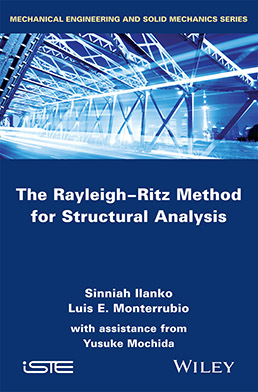
In many practical engineering problems, it is neither possible nor convenient to develop exact solutions. A convenient method for solving such problems originated from attempts to calculate natural frequencies and modes of structures. This method is known as the Rayleigh–Ritz Method or simply the Ritz Method.
This book is a presentation of the theory behind the Rayleigh–Ritz (R–R) method, as well as a discussion of the choice of admissible functions and the use of penalty methods, including recent developments such as using negative inertia and bi-penalty terms.
While presenting the mathematical basis of the R–R method, the authors also give simple explanations and analogies to make it easier to understand. Examples include calculation of natural frequencies and critical loads of structures and structural components, such as beams, plates, shells and solids. MATLAB codes for some common problems are also supplied.
1. Principle of Conservation of Energy and Rayleigh’s Principle.
2. Rayleigh’s Principle and Its Implications.
3. The Rayleigh–Ritz Method and Simple Applications.
4. Lagrangian Multiplier Method.
5. Courant’s Penalty Method Including Negative Stiffness and Mass Terms.
6. Some Useful Mathematical & Derivations and Applications.
7. The Theorem of Separation and Asymptotic Modeling Theorems.
8. Admissible Functions.
9. Natural Frequencies and Modes of Beams.
10. Natural Frequencies and Modes of Plates of Rectangular Planform.
11. Natural Frequencies and Modes of Shallow Shells of Rectangular Planform.
12. Natural Frequencies and Modes of Three-dimensional Bodies.
13. Vibration of Axially Loaded Beams and Geometric Stiffness.
14.The RRM in Finite Elements Method.
Sinniah Ilanko is Professor in the School of Engineering at the University of Waikato in New Zealand and is currently also the Head of School. His research interests include stability and vibration of structures, stress analysis, numerical modelling and engineering education. He teaches or has taught Engineering Mechanics, Mechanics of Materials, Structural Analysis, Numerical Analysis and Finite Element Method. He has been serving as a Subject Editor for the Journal of Sound and Vibration since January 2009.
Luis E. Monterrubio is Assistant Professor in the School of Engineering Mathematics and Science at Robert Morris University, PA, USA. His research interests include stability and vibration of structures, stress analysis, numerical modelling and engineering education. He has work experience in testing, simulations and manufacturing in the automotive industry. He teaches Numerical Methods, Dynamics, Machine Design and Finite Element Method. He is a member of the American Society of Mechanical Engineers.
Yusuke Mochida currently holds a Postdoctoral Research/Teaching Fellowship at the University of Waikato in New Zealand. His research interests include vibration of structures, particularly plates, shells and solids and computational mechanics (Superposition Method, the Rayleigh-Ritz Method, Finite Difference Method). His current research focus is on developing a general analytical procedure for vibration analysis of complex structures, including the use of the concept of negative structures to represent voids.